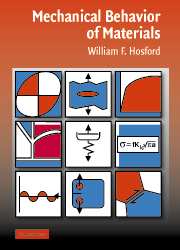Book contents
- Frontmatter
- Contents
- Preface
- Note to the Reader
- 1 Stress and Strain
- 2 Elasticity
- 3 Tensile Testing
- 4 Other Tests of Plastic Behavior
- 5 Strain-Hardening of Metals
- 6 Plasticity Theory
- 7 Strain-Rate and Temperature Dependence of Flow Stress
- 8 Slip
- 9 Dislocation Geometry and Energy
- 10 Dislocation Mechanics
- 11 Mechanical Twinning and Martensitic Shear
- 12 Hardening Mechanisms in Metals
- 13 Ductility and Fracture
- 14 Fracture Mechanics
- 15 Viscoelasticity
- 16 Creep and Stress Rupture
- 17 Fatigue
- 18 Residual Stresses
- 19 Ceramics and Glasses
- 20 Polymers
- 21 Composites
- 22 Mechanical Working
- Appendix A Miller Indices
- Appendix B Stereographic Representation of Orientations
- Index
20 - Polymers
Published online by Cambridge University Press: 05 June 2012
- Frontmatter
- Contents
- Preface
- Note to the Reader
- 1 Stress and Strain
- 2 Elasticity
- 3 Tensile Testing
- 4 Other Tests of Plastic Behavior
- 5 Strain-Hardening of Metals
- 6 Plasticity Theory
- 7 Strain-Rate and Temperature Dependence of Flow Stress
- 8 Slip
- 9 Dislocation Geometry and Energy
- 10 Dislocation Mechanics
- 11 Mechanical Twinning and Martensitic Shear
- 12 Hardening Mechanisms in Metals
- 13 Ductility and Fracture
- 14 Fracture Mechanics
- 15 Viscoelasticity
- 16 Creep and Stress Rupture
- 17 Fatigue
- 18 Residual Stresses
- 19 Ceramics and Glasses
- 20 Polymers
- 21 Composites
- 22 Mechanical Working
- Appendix A Miller Indices
- Appendix B Stereographic Representation of Orientations
- Index
Summary
Introduction
A separate chapter is devoted to polymers because of their engineering importance and because their mechanical behavior is so different from that of metals and ceramics. The mechanical response of polymers is far more time-dependent than that of crystalline materials. Viscoelastic effects (Chapter 15) are much more important in polymers than in metals or ceramics. The properties of polymers are also much more sensitive to temperature than those of other materials. Changes of molecular orientation with deformation cause large changes in properties and a much greater degree of anisotropy than is observed in metals or ceramics. The phenomena of crazing and rubber elasticity have no analogs in crystalline materials. Some polymers exhibit very large tensile elongations. Although a few alloys exhibit shape-memory behavior, the effect is much greater in polymers, more common, and of greater technological importance.
Elastic behavior
Elastic strains in metals and ceramics occur by stretching of primary metallic, covalent, or ionic bonds. The elastic modulus of most crystals varies with direction by less than a factor of 3. The effects of alloying, and of thermal and mechanical treatments on the elastic moduli of crystals are relatively small. As the temperature is increased from absolute zero to the melting point, Young's modulus usually decreases by a factor of no more than 5. For polymers, however, a temperature change of 30°C may change the elastic modulus by a factor of 1000.
- Type
- Chapter
- Information
- Mechanical Behavior of Materials , pp. 345 - 371Publisher: Cambridge University PressPrint publication year: 2005



